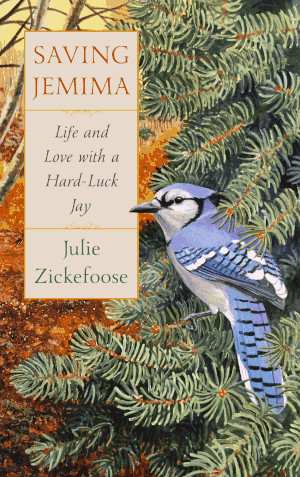This is a book that I enjoyed tremendously and it touched me in unexpected ways. Julie Zickefoose is a nature artist and licensed wildlife rehabilitator in the Appalachian foothills of Ohio. This is her story about how she rescued an orphaned blue jay, nursed it back to health and released it back into the wild.
Although the author was frequently inundated with inquiries about how to care for injured birds, this particular request was closer to home and when she looked at the photo of the bird who was clearly in trouble, there was something in the bird's eyes... (well, you will find that Julie has a tremendous heart!)
What follows is the story of what happens to Jemima and how this bird was a life-saver to the author herself, who was going through the hardships of both of her children leaving home, a marital break-up and more.
Both Michael and I love to watch birds in our garden and I particularly love the raucous Scrub Jays and the less-often seen Stellar Jays. I feed them peanuts all the time and they provide me with lots of entertainment. I don't know that much about them, however, but after reading this book, I've learned some valuable things about their habits, diet and the way they interact with other birds and humans.
We learn that blue jays look a lot alike and it is almost impossible to tell males from females. Julie, who has studied birds her entire life and has a massive library of photographs that she has taken over the years, began to notice subtle differences in patterns and shadings around the face and eye area. Eventually she could recognize Jemima after she began to leave the house and return after extended periods.
Once Jemima begins to recover from her initial ordeal, her energy and magnetic personality forms. She is boisterous, loves music (especially Ed Sheeran) and forms bonds with pet dog Chet Baker and especially Julie's daughter, who visits regularly from college.
But there are numerous trials and worries along the way and the book can be quite suspenseful. After Jemima develops an eye infection caused by Mycoplasma (you will learn all about it), I couldn't stand it and had to flip forward a few chapter to make sure she was going to be okay. Other adversities will arise but you learn that birds have a strong survival instinct.
As wonderful as the story is, the book is also a very beautiful one, illustrated with the author's drawings and abundant photos.
Educational, emotional, and captivating, I highly recommend it.



I first heard about this book when the the author was interviewed on Margaret Roaches' podcast (A Way to Garden) , maybe a year or so ago. I slipped out of my mind after that and your post has reminded me. I feed the scrub jays too-though I have to be strategic due to the squirrel activity in my neighborhood . My Jays like to hide the peanuts and I've unintentionally grown the occasional peanut plant .
ReplyDeleteI heard about it on a YouTube book reviewer channel. Totally out of the blue. Yes, those pesky squirrels...
DeleteIt sounds like a great book for a bird lover. I've refilled my feeders to give the birds a boost during what passes for winter here, which has brought back the jays - and the squirrels.
ReplyDelete